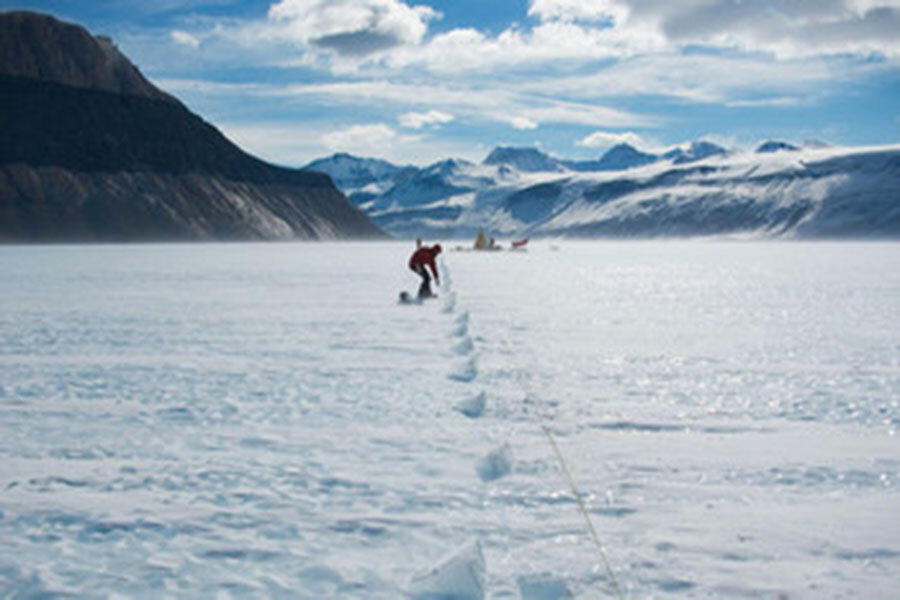How old is that ice? New dating technique could spot 1.5-million-year-old ice.
Loading...
There is a lot we sill don't know about our planet's past.
To fill this information void, researchers intend to use a novel dating technique on ancient chunks of ice in Antarctica, to accurately determine their age and to learn about the Earth's history.
This technique uses krypton, an odorless, colorless gas present in trace amounts in the Earth's atmosphere. Researchers tested this method on a 120,000-year-old sample of Antarctic ice. The researchers had already established the age of the ice, having "done a very large amount of work on the gas content of that ice, and the ice around it, to know how it fits in to dated ice cores that have continuous data all the way from today to older times than that," Edward Brook, an Oregon State University geologist and co-author on the study wrote in an email.
The krypton dating method worked, returning a result of 120,000 years. The same dating technique, say the researchers, can be used to determine age of ice up to 1.5 million-year-old.
Much like carbon-14 dating, krypton dating measures the decay of radioactive isotopes. But there are significant differences between the two.
Carbon dating works for objects that are up to about 50,000 years old. Krypton, by contrast, is an inert gas that makes it more stable. It doesn't interact chemically and has a half-life of around 230,000 years, said Christo Buizert, a postdoctoral researcher at Oregon State University and lead author of the study. Produced by cosmic rays bombarding the Earth, Krypton is stored in air bubbles within the ice found in the Antarctic. By comparing the ratio between radioactive isotopes (Krypton-81) that decays slowly with a stable isotope (Krypton-83) that does not decay, researchers can determine age of the ice.
But "[i]t is unlikely that 81Kr dating will work in young (less than say 50,000 year) ice because of this long half life, whereas if we could get around the problem of 14C produced in ice we could use it to date ice in that younger range," Dr. Brook wrote in an email.
Until 2011, before the new atom counter, named Atom Trap Trace Analysis, or ATTA, was developed, it was difficult to determine the age of ice using this method because Krypton-81 atoms are so few that it is difficult to count them. But with the ATTA, researchers can now capture and count individual atoms.
In this experiment, Krypton was extracted from the air bubbles in four 770-pound polar ice samples from Taylor Glacier, Antarctica, and dated using ATTA, researchers note in their paper. The ice samples were extracted using the Blue Ice Drill, which Brook describes as "a fairly simple but elegant device" designed to obtain "large ice cores (10 inches in diameter) from “blue ice,” which is shorthand for solid ice exposed at the surface of glaciers or ice caps," he adds.
To determine the amount of Krypton, the chunks of ice first have to be melted to release the air from the bubbles, which was stored in flasks. Krypton that was isolated from air was then sent to Argonne National Laboratory near Chicago, which houses the ATTA. "The atom trap is so sensitive that it can capture and count individual atoms," said Dr. Buizert "The only problem is that there isn't a lot of Krypton in the air, and thus there isn't much in the ice, either. That's why we need such large samples to melt down."
The scientists now aim to further improve the ATTA detector so that the level of the gas can be determined using a smaller sample of ice. "We can perform Krypton-81 dating on an ice sample of 40-80 kilograms," said Zheng-Tian Lu, a researcher at Argonne and a co-author of the paper. "Within a year, we aim to perform analysis on an ice sample as small as 20 kilograms."
The next step of the challenge is to locate some old ice that could help the team to study ice age cycles of the past.
"Very old ice probably exists in small isolated patches at the base of the ice sheet that have not yet been identified, but in many places it has probably melted and flowed out into the ocean." said Brook. Some places where "meteorites originating from Mars have been pushed out by glaciers and collect at the margins. Some have been on Earth for a million years or more, so the ice in these spots may be that old as well," he added.
The findings of the study are published in a paper titled "Radiometric 81Kr dating identifies 120,000-year-old ice at Taylor Glacier, Antarctica" in the Proceedings of the National Academy of Sciences (PNAS).








